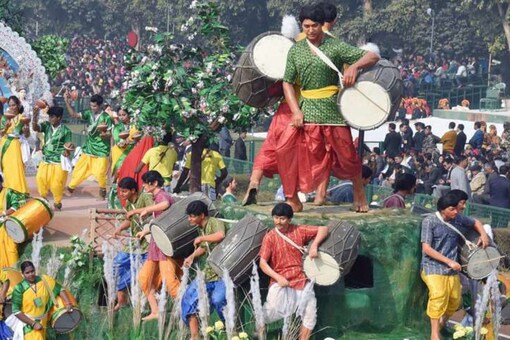
R-Day Parade: A Look at How Tableaux are Selected as Row Breaks Out Over Centre's Rejection of Bengal’s Proposal
In a letter to the chief secretaries of all states and UTs, the Defence Ministry had said that the selection process of tableaux is an elaborate exercise and in view of time constraints, only a limited number of proposals would be included.
 |
| Every year, only a select number of tableaux from states and ministries of the central government participate in the Republic Day parade. (Representative image/PTI) |
Amrita Nayak Dutta, News 18: A political row has broken out between the Centre and West Bengal after the former excluded the state’s tableau — themed on Netaji Subhas Chandra Bose and the INA on his 125th birth anniversary year — for the upcoming Republic Day parade on January 26.
In a letter to Prime Minister Narendra Modi, West Bengal Chief Minister Mamata Banerjee expressed shock and hurt at the decision, highlighting that the state’s tableau was rejected without assigning any reason. She asked the Prime Minister to reconsider the decision and include the tableau of freedom fighters from the state in the R-Day parade in the 75th year of India’s Independence.
This is not the first time that the state tableau for Republic Day parade has been rejected. In 2020, too, tableaus from West Bengal, Maharashtra, Kerala and Bihar were rejected, leading to an outcry from the states.
Bengal at that time had alleged that the exclusion happened because the state opposed the Citizenship Amendment Bill. The claim was rejected by the Defence Ministry, which said the West Bengal government’s proposal was turned down after an expert committee examined it in two meetings.
However, in 2016, Bengal’s tableau on its folk baul singers was selected as the best. The three best tableaux receive trophies from the Defence Ministry.
Every year, only a select number of tableaux from states and ministries of the central government participate in the Republic Day parade.
In a letter to the chief secretaries of all states and Union Territories in September, the Ministry of Defence had said the selection process of tableaux is an elaborate and time-consuming exercise, and that in view of time constraints, the ministry will be able to include only a limited number of proposals.
As per this letter, the theme for the Republic Day parade of 2022 would be ‘India@75’ to commemorate 75 years of India’s independence.
HOW TABLEAUX ARE SELECTED
The Defence Ministry constitutes a committee of distinguished persons drawn from various fields to shortlist the best tableau proposals received.
This expert committee — comprising prominent people in the fields of art, culture, painting, sculpture, music, architecture, choreography among others — holds six to seven rounds of meetings to evaluate the proposals to carry out the shortlisting and the final selection.
In the first phase of selection, the sketch or design of the proposals is examined and suggestions for modifications, if any, are carried out. Once approved by the committee, the participants have to present three-dimensional models of their proposals. The models are then examined again by the expert panel for final selection.
The final selection of a tableau is based on a combination of factors, including visual appeal, impact on the masses, idea behind it, degree of detailing that went behind it and also the music accompanying it.
Only the official representative of an organisation will interact with the members of the committee. Artists or designers of the tableau do not interact directly with the panel members unless directed otherwise. Only one tableau participates from an organisation in the parade.
According to the sources in the government, 21 proposals were shortlisted out of the total 56 received from states and central ministries.
The Subject Expert Committee rejected the proposals of Kerala, Tamil Nadu and West Bengal after deliberations and a due process, the sources added.
They also said it is natural for more proposals to be rejected than those approved given the paucity of time.
They further said the outcry over the rejection of tableaux sets a wrong precedent as chief ministers try to portray the outcome of an “objective” process as a flashpoint between the Centre and states. They said this goes a long way in harming the country’s federal structure.
The tableaux proposals of Kerala were accepted through the same process in 2018 and 2021, while the tableaux proposals of Tamil Nadu were accepted in 2016, 2017, 2019, 2020 and 2021.
The tableaux proposals of West Bengal were accepted in 2016, 2017, 2019 and 2021.
(Amrita Nayak Dutta, News Editor at CNN-News18, writes on key government policies and their implications. )
(https://www.news18.com/news/india/r-day-parade-a-look-at-how-tableaux-are-selected-as-row-breaks-out-over-centres-rejection-of-bengals-proposal-4666208.html)

0 Response to "R-Day Parade: A Look at How Tableaux are Selected as Row Breaks Out Over Centre's Rejection of Bengal’s Proposal"
Post a Comment
Disclaimer Note:
The views expressed in the articles published here are solely those of the author and do not necessarily reflect the official policy, position, or perspective of Kalimpong News or KalimNews. Kalimpong News and KalimNews disclaim all liability for the published or posted articles, news, and information and assume no responsibility for the accuracy or validity of the content.
Kalimpong News is a non-profit online news platform managed by KalimNews and operated under the Kalimpong Press Club.
Comment Policy:
We encourage respectful and constructive discussions. Please ensure decency while commenting and register with your email ID to participate.
Note: only a member of this blog may post a comment.